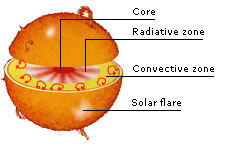DK Space: Sun
At the center of the Solar System is the Sun, a vast globe of glowing gas that pours energy into space as light and heat. From Earth, it looks the same size as the Moon, which covers it during a SOLAR ECLIPSE.
Table 2. SUN DATA
| SUN DATA | |
|---|---|
| Diameter (distance across) | 865,000 miles (1.4 million km) |
| Average distance from Earth | 91 million miles (147 million km) |
| Time to spin around own axis | 25.4 days (at equator) |
| Mass | 330,000 x Earth’s mass |
| Density | 1.4 x density of water |
| Average surface temperature | 9,900°F (5,500°C) |
| Core temperature | 27 million°F (15 million°C) |
| Age | 4.6 billion years |
The Sun is made up mainly of hydrogen (about 73 percent) and helium (about 25 percent). There are also traces of around 60 other elements (about 2 percent). Hydrogen is the fuel in the nuclear reactions that produce the Sun’s energy.
The surface of the Sun heaves and boils as pockets of hot gas well up and sink back down. This gives the surface a grainy look, which is known as granulation. Violent explosions called solar flares rip through the surface, and giant fountainlike eruptions called prominences shoot super-hot gas far into space. Darker areas called sunspots often appear. They are about 2,700°F (1,500°C) cooler than the gas around them.
A solar eclipse happens when the Moon passes between Earth and the Sun. It is a partial eclipse if the Moon covers only part of the Sun, and a total eclipse if the Sun is covered completely. Two to five solar eclipses can be seen from somewhere on Earth each year.
When the Sun is completely covered, day suddenly turns into night, the air chills, and birds start to roost. Totality (the period of darkness) can last up to 7 1/2 minutes, but is usually much shorter. During totality, the pink inner atmosphere of the Sun, the chromosphere, shows up. The pearly white outer atmosphere, the corona, is also visible, and prominences can sometimes be seen around the Moon’s dark edge.

